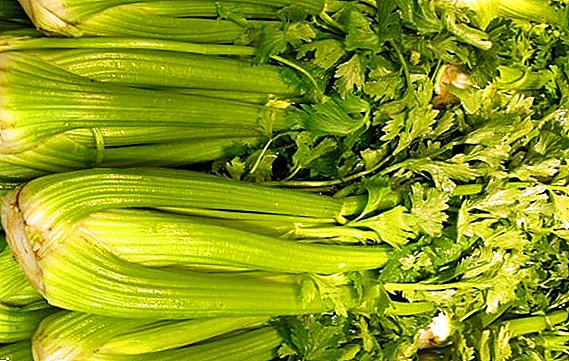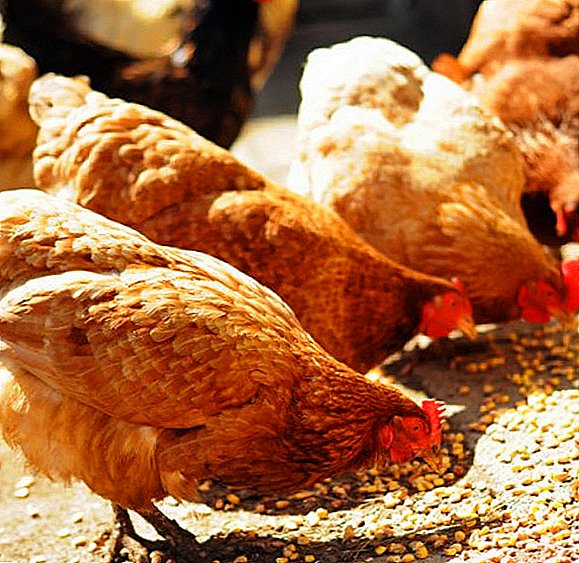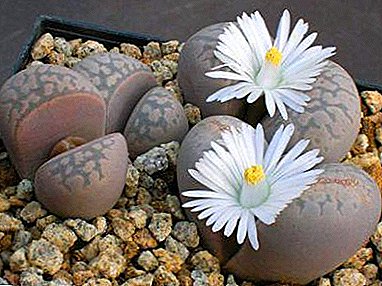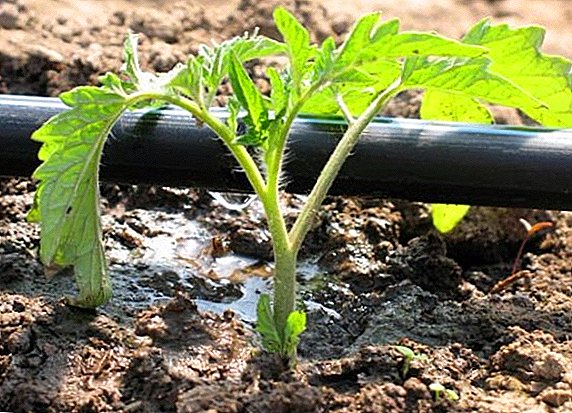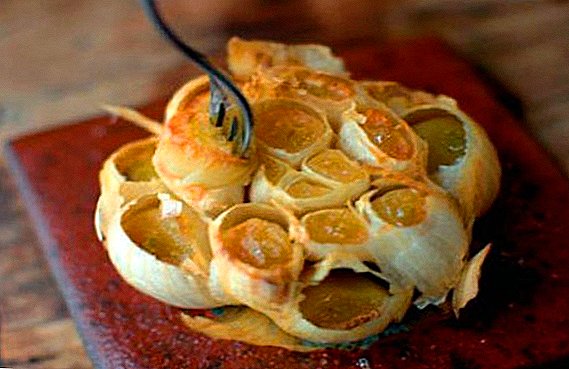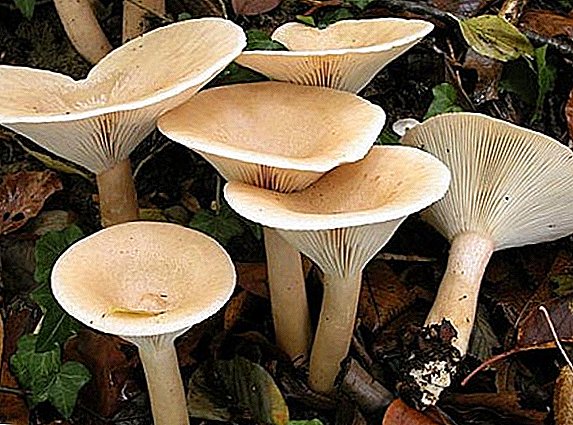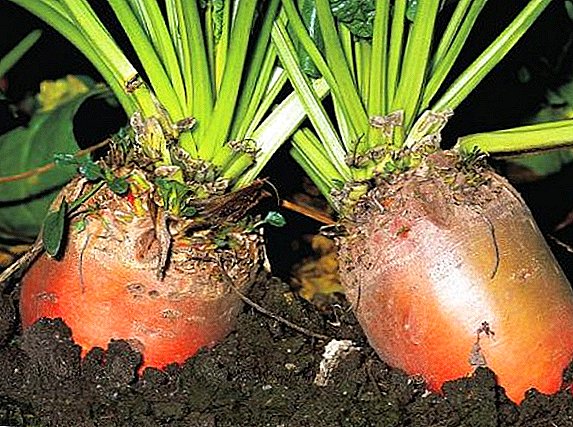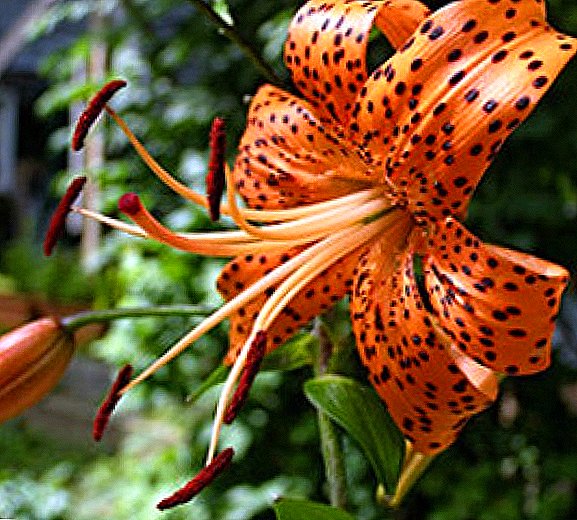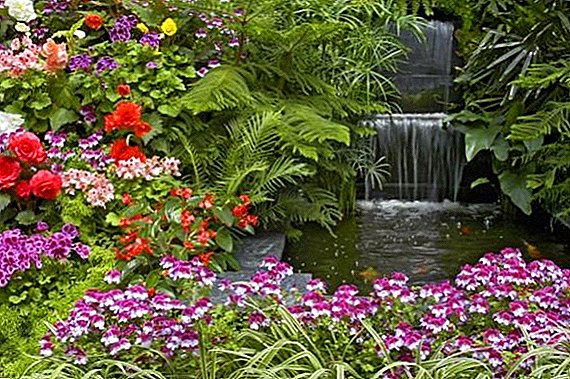 One of the factors affecting the success of rabbit rearing is a spacious, cozy cage. At home, it is easy to build from scrap materials.
One of the factors affecting the success of rabbit rearing is a spacious, cozy cage. At home, it is easy to build from scrap materials.
The main thing is that the design fully complies with all requirements of eared residents.
What exactly needs to be taken into account in the process of construction, what kind of rabbitry to prefer and how to build it - we will tell about this later in the article.
What should be rabbitry
The development of infectious diseases, frequent injuries and poddermatitis are the first signs of improper keeping of rabbits. In the future, this will inevitably lead to a decline in productivity and loss of livestock. In order to avoid losses, the breeder needs, in addition to the front of feeding and watering, to pay close attention to the specifics of rabbit housing and animal planting density.
Important! On cramped areas in rabbits, metabolic processes are disturbed, growth stops and aggression towards the whole environment is manifested. Experts advise to place adults one by one, and young animals - by four. And for the neighborhood, animals of the same sex are selected, with the same development and temperament.
General requirements
According to rabbit breeding requirements, a well-designed rabbitry should not only protect pets from inclement weather, but be a cozy home for them with good lighting, ventilation and walking distance. It is important to provide adjustment of the impact of external factors that depend on the time of day, season, weather.  For the construction of rabbit housing suitable any material. However, experienced breeders advise the use of a wooden frame and a net fence. This is due to their reliability and durability. In addition, in the heat of the wood does not heat up, which is very important for residents.
For the construction of rabbit housing suitable any material. However, experienced breeders advise the use of a wooden frame and a net fence. This is due to their reliability and durability. In addition, in the heat of the wood does not heat up, which is very important for residents.
It is unacceptable that rabbit feces are collected inside the structure. Ammonia and hydrogen sulfide fumes will provoke respiratory infections in pets, and dampness and dirt will serve as a favorable environment for the development of pathogenic bacteria and fungi.
Important! For eared pets, fine spinous straw or hay is not recommended as bedding. Preferred soft awnless cereals. They are used as bedding from late autumn until spring. At other times of the year, covering the floor is necessary only in cages with pregnant females. And then they do it for 5 days before okrol.
To solve this problem and facilitate maintenance of the rabbit, many breeders advise installing a mesh floor inside the structure. Experts strongly discourage such an initiative, citing a high degree of injury and frequent cases of trauma in rabbits. The best option is wooden slats and a soft mat laid on top of them.  Also, a rabbit breeder should take into account the sensitivity of their wards to air exchange and dampness. Consequently, a good ventilation system, excluding drafts, should be provided in their home. To ensure high productivity, experts advise to keep the humidity in the cell at the level of 60-70%.
Also, a rabbit breeder should take into account the sensitivity of their wards to air exchange and dampness. Consequently, a good ventilation system, excluding drafts, should be provided in their home. To ensure high productivity, experts advise to keep the humidity in the cell at the level of 60-70%.
Learn more about rabbit hygiene.
Choosing a place
The features of the rabbit abode are that it should not collect ultraviolet rays on itself, and at the same time should be a reliable protection for its residents from dampness and cold. This can be achieved by choosing the right place to house the rabbit.
Experienced breeders advise:
- Avoid wetlands, because this kind of soil will lead to rapid deterioration of the material, as well as to diseases and death of pets.
- Give preference to elevated areas away from the lowlands, water bodies and other sources of dampness.
- Putting rabbit cages in shady areas, as the animals react painfully to direct sunlight. This is especially true in the summer. Otherwise, to protect the eared from the scorching sun will have to with the help of an additional canopy.
- Keep pets away from noise. Consequently, for rabbitrers, places near the production areas, busy highways or in the vicinity of predators are absolutely not suitable.
- Place the building on the east or west side, because eared are very afraid of wind and drafts. For protection, you can plant the northern wall of the rabbitry with a thick hedge.

Did you know? Australian legislation strictly prohibits domestic breeding of rabbits, punishing violators with a fine of 30 thousand dollars. The ban is associated with damage that wild animals annually cause agricultural land. Locals consider them the most destructive pests, accusing them of the destruction of crops, erosion of soils and the disappearance of some species of fauna. According to local government estimates, every year the country suffers damage of about $ 600 million from the stormy rabbit activities.
Design
Depending on the number of tenants, plan the dimensions and type of rabbitry. It is important for the builder to understand that the entire area of the structure will be further divided into a walking compartment and a deaf zakut. The first zone in most cases is the space under the cage fenced off by the grid. And the second is a deaf box.
A removable door is fastened on the front side of the building, and a small manhole is provided on the wall adjacent to the free-standing space. Under the floor, be sure to provide a pan to collect feces.  Many breeders for group breeding eared use group multi-tiered design. On them, as well as on the simplest cells, it is recommended to provide a single or gable roof. Usually it is made on the last tier, and all the previous ones are covered with pallets.
Many breeders for group breeding eared use group multi-tiered design. On them, as well as on the simplest cells, it is recommended to provide a single or gable roof. Usually it is made on the last tier, and all the previous ones are covered with pallets.
Whichever option you choose, the rabbit house must be inaccessible to rodents and predators. Therefore, it is recommended to install it at a height of 80-100 cm from the ground. In addition, this solution will greatly facilitate the care of animals.
Important! In the houses for rabbits, the movement of air in excess of 30 m / s is undesirable.
For the winter, the cell must be insulated so that the temperature inside the room corresponds to the range + 10-20 ° C. Also, the builder should provide for the possibility of additional lighting of enclosed structures. In the cold season, the length of daylight hours for rabbits should be at least 10 hours. Ideally, this problem is solved using a window installed on the east wall.

Varieties
Faced with various difficulties in growing eared animals, rabbit breeders are constantly improving home-made rabbitks. Therefore, today there are many projects of their construction.
The most popular with breeders are the following options:
- cell with mother liquor;
- multisection versions;
- single;
- solid wire;
- paired designs;
- rabbitries Zolotukhin;
- mini-farm Mikhailov.
Familiarize yourself with the features of manufacturing rabbit Zolotukhin.
How to make a rabbit with their own hands
The construction of the rabbitry is actually a simple task if you have all the necessary drawings on hand. But to create them, the first thing to do is to determine the number of rabbits and the type of design. And then you can proceed to the most difficult and crucial stage. 
Dimensions and drawings
Dimensions of rabbit housing are based on its purpose and characteristics of the breed. These nuances should be taken into account by correcting the following versions of the drawings. For convenience, we offer to be guided by a selection of professional recommendations:
Did you know? The left rabbit's foot in many cultures of the world, including Europe, North and South America, Africa and China, is revered as a talisman of good luck and happiness. It is likely that belief in the magical power of eared legs originated in European countries from the 600s BC. er among the Celtic peoples.
- The classic version of the queen cells provides for the length of the walls in the range of 170-180 cm, height of 60-70 cm and a depth of at least 100 cm.

- The height of the excavated supports, on which the entire structure is installed, must correspond to 70-80 cm from the ground (do not forget to leave a margin for the recess.
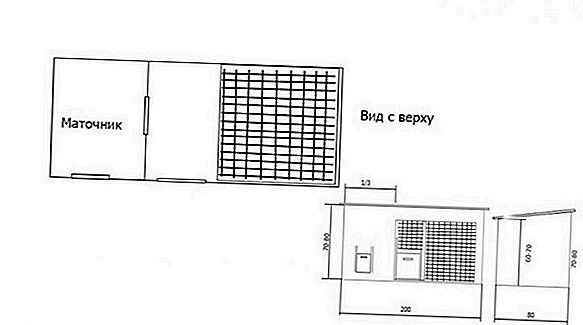
- For adult rabbits weighing from 5 kg, the size of the room is calculated taking into account 130-150 cm length, 70 cm depth and 50 cm height.

- The maintenance of young stock requires the construction of multi-sectional structures, where at the same time 8-20 heads would fit. In each section, no more than 4 rabbits are put in age from 0 to 3 months. Consequently, the height of the cage can be reduced to 35 cm, but the area of the pen is increased to 0.25 square meters. m
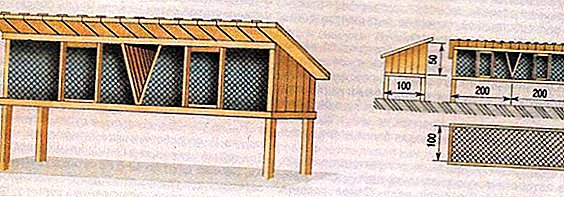
- Grown up youngsters are grown in individual designs, the minimum sizes of which correspond to 100 × 60 × 60. If we are talking about sexually mature males, then these dimensions should be increased by 30%, otherwise a sedentary lifestyle in cramped conditions will lead your pets to infertility.
- When building multilevel sheds, consider their maximum length 210 cm and depth 100 cm.

Very comfortable single or two-piece design for outdoor walking under the cage. The construction is a wooden frame with a ladder and a mesh fence.
Important! According to experts, among all the available variety of building materials, wood has recommended itself best of all. It is eco-friendly, durable and well retains heat, does not heat up in the heat. Strongly not suitable for such structures metal. In winter, animals in such a house can freeze, and in summer - overheat. Also avoid using chipboard. This material quickly absorbs moisture, causing it to crumble.To create drawings, you need to decide on the arrangement of all components. The builder must understand from which side in the rabbit house there will be doors, a window, feeders, drinkers, nesting and walking compartments. In the classic rabbit versions, the side and rear walls remain deaf. From the nest provide a small manhole. Also important is the descent to vygulnuyu territory.
Materials and tools
Before starting the construction, prepare everything you need, so that you do not get distracted by empty searches. Many rabbit breeders who make their own homes for pets use scrap materials.  In our case, it will be enough to prepare:
In our case, it will be enough to prepare:
- 10 wooden bars with a length of 3 m, with a cross section of at least 60 × 60 mm (for the frame);
- plexiglass;
- soft tile (ruberoid, polycarbonate or slate will be suitable as an alternative);
- planed boards about 30 mm thick;
- plywood sheets 1.5 × 1.5 m in size and 10 mm thick (for plating);
- wooden slats with a cross section of 25 × 40 mm;
Find out what and how to make the mother liquor.
- welded mesh with cells 2.5 × 2.5 cm;
- bolts, screws, fasteners and nails;
- furniture dowels;
- gate valves;
- door hinges;
- handles (for transportation);
- metal sheet 1 m long (for the construction of a pallet);
- iron corners;
- foam plastic (for insulation and sound insulation);
- pipe (for ventilation)
 To work the master will need:
To work the master will need:- pencil (for marking);
- roulette;
- hammer;
- Bulgarian;
- perforator;
- sandpaper coarse fraction;
- elastic glue;
- sharp metal shears;
- riveter or construction stapler;
- saw for wood;
- passatizhi.
Did you know? A 2-pound rabbit can eat half a sack of feed in one sitting and drink as much water as a 10-pound dog.
Step-by-step instruction
When the entire arsenal of necessary tools and building materials is assembled, you can proceed to the measurements and preparation of parts. Let's start in order.
Frame
For the manufacture of this part of the rabbit, 4 vertical supports and 8 transverse bars will be needed. The action algorithm is as follows:
- In accordance with the drawings, measure the desired length and saw off the workpiece.
- Drill holes at the ends of the details and with the help of metal corners attach them with screws. In the case of a multi-tiered structure, be sure to provide a space of up to 15 cm for each pallet after each tier.

- The front and rear bars connect the transverse slats. This is the basis for the cell.

- Measure from the harvested wooden bars 4 legs to the rabbit house. Prick them to the resulting wooden rectangle so that the height remains a margin of 30-40 cm to the floor.

- Now you can start the construction of a deaf pen. Many breeders build it with a removable plywood bottom to prevent increased damp inside the cage.
 Therefore, this part of the house must be completely made of boards or plywood.
Therefore, this part of the house must be completely made of boards or plywood.
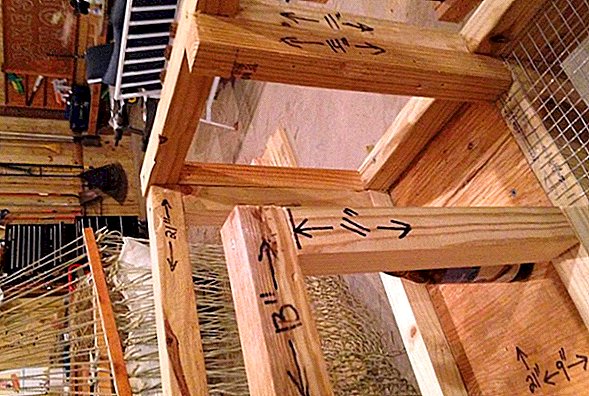
- Install a plywood partition with an oval hole for the passage of rabbits between the nesting and walking areas.

- Now lay the floor on the bottom of the rack structure, leaving 1.5 cm gaps between them. If you retreat more, the animals will get stuck in the gaps and injure their paws.
- Cover the framework with boards, having provided a window opening.


Did you know? The eyes of rabbits are arranged in such a way that, without turning around, they can observe what is happening behind them.
Roof
In this case, a double slope roof is proposed. In its manufacture will be involved frame slats and polycarbonate.
So, we proceed:
- From the rails build the base. Fasten with screws or nails.
- Secure the cooked part to the main frame of the rabbit house.
- Boards sew the base of the roof.
- Cover with roofing material, securing it with self-tapping screws.

Doors
In the design under consideration, there are 2 doors: the first for servicing the rabbitry, and the second for accessing the animal to the walking area.
Find out what points you should pay attention to when choosing a cage for rabbits.
They are made as follows:
- Make a frame from the rails, the dimensions of which should not exceed one third of the facade wall of the structure. Details fasten at the expense of metal corners.
- Sew a plywood sheet. Alternatively, any other solid material can be used.
- Drill holes for mounting canopies, after making their measurements.
- At the final stage, attach the door latch.
- The second door leading to the walking area, make the same principle. Its dimensions should be calculated within 35 × 45 cm. At the same time, it should pass freely in the opening.
- Fastening the second door provides for the use of hinges in the upper part, so that the ward with a light touch can freely go and enter.

Sheathing of the walls and door of the walking area
At this stage the rabbit house and the frame of the walking area attached to it should already be ready. Its base is made of 5 rectangles of the same height, which will serve as the walls of the building.
Sex for walking is not necessary, because it will be replaced by grass. This option is very convenient in that the animal will always have access to succulent feed.
But do not forget about the ability to dig eared burrows. To keep pets from escaping through the tunnel, it is recommended that the bottom edge of the net be dug 20 cm into the ground during the plating process.
Did you know? Rabbits chew 120 times a minute and have over 17 thousand taste buds..
Further actions are as follows:
- Attach the mesh to the fabricated frame using tin clips.
- Cover the paddock with a lightweight waterproof material.
- Separately, by the same principle, fasten the mesh fence on the door frame. After that, attach the latch.

Ladder
This detail should be placed in the rabbitry so that the animal could easily get inside the house. Experienced breeders advise to make a smooth slope, but at the same time the bottom edge of the ladder should not rest against the wall of the fence.
Check out the advantages and disadvantages of breeding rabbits for earnings.
So, we proceed to construction:
- On a flat surface, attach transverse strips to 2 parallel to the laid long rails (there should be at least 5 of them).
- Sew a gap in one piece. Alternatively, you can use a sheet of plywood. Extremely undesirable for such purposes, metal, plastic and other slippery materials. It is important to ensure that there are no large gaps in the design, since these defects are fraught with injuries to the pet.
- Using self-tapping screws, attach the ladder to the base of the house.

Feeders and drinkers
In the house near the door, attach a manger for hay. For this ideal metal rods attached to the walls at a slight angle.
In addition to the already provided sennik in the rabbitrel you need to put a water bowl and a feeder. It is important that these containers can not be overturned or clogged with animal excrement.
Learn more about how to make feeders, bunker feeders and drinkers for rabbits.
Therefore, experienced breeders advise to get a purchased drinker, which from the inside is attached to the front side of the cage. A feeder can be built independently.  This is done like this:
This is done like this:
- In the rabbit house to one of the walls (choose the one to which it will be convenient to feed your pets without scaring them) vertically attach 4 wooden slats so that you have a rectangle out. This will be the frame of the bunker. The length of the blanks should correspond to the height of the walls, because the trough will be filled through the raised roof. If this is not possible, then the height of the tank will have to be reduced by a quarter so that the animal is comfortable to get food. The bottom of the formed figure should be 10 cm long.
- Having retreated 10 cm from the last pair of nailed rails, pin similar 2 blanks, reducing their length by a quarter. Это будет каркас самой кормушки.
- Зашейте боковые стороны Г-образного каркаса вырезанными из фанеры деталями соответствующей формы.
- The front side of the bunker, too, close the vertical plywood rectangle. Note that its long side should not rest against the floor, since such an arrangement of parts will block access to the animal feed.
- From plywood cut the bottom of the feeder and attach it.
Important! The rabbit breeder needs to carry out a general cleaning every six months in the rabbit house with its complete disinfection. This procedure is carried out with the help of chemicals and a blowtorch..
Winter cell insulation
To wards rabbits comfortably wintered, without reducing their productivity, it is necessary to warm the rabbit from the inside with foam plastic. Also for these purposes you can use:
- moss;
- fallen leaves;
- straw;
- dry reed;
- felt.
After that, put a thick layer of bedding on the floor. In the autumn-spring period, it is important for rabbits that their paws are protected from pressure sores and cold. Sawdust, coarse straw or hay of soft awnless grass crops are ideal for bedding.  Particularly attentive to the choice of material should be with the content of downy breeds. Caught in their coat awnings cause discomfort and pain. Straw is preferable for bedding because it keeps you warm and is safe for the rabbit.
Particularly attentive to the choice of material should be with the content of downy breeds. Caught in their coat awnings cause discomfort and pain. Straw is preferable for bedding because it keeps you warm and is safe for the rabbit.
Remember that the larger the pet, the more litter it needs. For adults, a layer thickness of 12.5-15.5 cm is suitable.
In the harsh winters, the rabbitks are covered with old cotton blankets and other warm clothes, and the inner space is filled with hay.
Important! The material for the manufacture of cells should be smooth, without traumatic foreign inclusions. Therefore, all preparations must first be thoroughly sanded with emery paper.
Now you know about the main requirements for a rabbit house, the density of animal landing and the creation of cozy conditions for their maintenance. We hope our article will help you to independently make a reliable and comfortable rabbit.
Video: DIY rabbit cages
Reviews about the rabbit breeding place













 Therefore, this part of the house must be completely made of boards or plywood.
Therefore, this part of the house must be completely made of boards or plywood.




